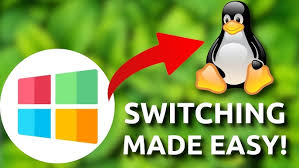How to Use Linux Like a Pro After Switching from Windows
Introduction
If you’re ready to explore new possibilities, it’s time to learn how to switch from Windows to Linux. Many users are making this switch for Linux’s customization options, security features, and open-source advantages. But, transitioning from Windows to Linux can feel overwhelming without the right guidance. This article offers tips to help you confidently navigate and master Linux.
Understanding Linux Basics
The Linux Interface
Linux’s desktop environments differ from Windows but offer plenty of flexibility. Common Linux desktop environments include GNOME, KDE Plasma, and Xfce, each with unique layouts and customization options. Choose one that feels intuitive, as this will make your transition smoother.
Linux Distributions: Finding the Right Fit
Linux comes in many distributions, commonly called “distros.” Popular choices include Ubuntu, Fedora, and Linux Mint, each catering to different users. Start with a beginner-friendly distribution like Ubuntu or Linux Mint to ease your learning curve.
Familiarizing Yourself with Linux Navigation
File Management in Linux
The Linux file structure differs from Windows. Instead of drives labeled “C:” or “D:”, Linux organizes files in a hierarchical tree starting from the root directory (/). Common folders include /home for personal files and /etc for system configurations.
Accessing Applications
Most Linux distros offer a software center, like Ubuntu’s Software Center or the Discover app in KDE, where you can browse and install applications. Unlike Windows, many applications are available as “packages” for quick installation, helping you find necessary tools without needing third-party sites.
Essential Commands for Linux Beginners
Learning a few basic commands can enhance your Linux experience. Commands are entered in the terminal, similar to Command Prompt in Windows. Here are some helpful ones:
ls: Lists files in the current directory.cd: Changes directories.mkdir: Creates a new folder.cpandmv: Copy and move files, respectively.
These commands might seem unfamiliar at first but offer efficient ways to navigate Linux.
Setting Up System Preferences
Customizing the Interface
One of Linux’s best features is its customization. You can change themes, icons, and even the desktop environment to suit your preferences. In GNOME, for example, extensions allow you to add custom widgets and features, while KDE offers detailed theme customization.
Managing System Settings
Unlike Windows, where settings are centralized, Linux may separate settings based on the desktop environment or specific system tools. Familiarize yourself with tools like “System Settings” (KDE) or “Settings” (GNOME) to manage your display, sound, and network preferences.
Exploring Software Alternatives
Office Productivity
Linux supports many office productivity tools, even though Microsoft Office isn’t natively available. Popular alternatives include LibreOffice, Google Workspace (online), and OnlyOffice, which support most Office file types.
Media and Graphics Software
For graphics, GIMP serves as a powerful alternative to Photoshop, and Inkscape offers vector graphic capabilities similar to Illustrator. VLC remains a popular choice for media playback on Linux, and there are many other multimedia tools available.
Staying Secure on Linux
Understanding Linux Security Benefits
Linux is often considered more secure than Windows due to its permission-based structure. Users do not typically operate with “root” or administrative privileges, reducing the risk of malicious changes to the system.
Updating Regularly
Linux updates are frequent and essential for maintaining security. Most distros notify you of available updates, which can be installed with a few clicks in the software updater tool or via simple commands like sudo apt update (for Ubuntu-based systems).
Antivirus on Linux
While Linux is secure, it’s still wise to use antivirus software, especially if you’re exchanging files with Windows users. Tools like ClamAV offer free antivirus protection and can be installed from the software center or terminal.
Making Use of Linux Community Resources
Forums and Online Communities
The Linux community is vast and supportive, with forums like Ask Ubuntu and Linux Mint’s Community offering valuable advice. Reddit and other forums also host Linux subgroups, where you can ask questions and find tutorials.
Tutorials and Guides
Many websites, such as Linux.org and YouTube, offer tutorials for all levels. These resources cover everything from basic setup to advanced configurations, allowing you to become more proficient over time.
Joining Local Linux User Groups
Local Linux User Groups (LUGs) are a great way to connect with other Linux users in person or virtually. These groups provide support and learning opportunities, especially for those new to Linux.
Tips for Daily Efficiency in Linux
Keyboard Shortcuts
Linux has many helpful keyboard shortcuts. For example, Ctrl + Alt + T opens a terminal, and Alt + Tab lets you switch between applications. Learning these shortcuts will help you use Linux more effectively.
Using Multiple Workspaces
Many Linux environments support multiple workspaces, allowing you to organize tasks better. Workspaces act as virtual desktops, so you can keep different projects or applications separated and reduce clutter.
Backing Up Regularly
Backup solutions like Timeshift can help you keep regular snapshots of your system. This tool is easy to use and invaluable if you accidentally make changes that need undoing.
Preparing for a Seamless Transition from Windows
Start with a Dual-Boot or Live USB
If you’re not ready for a full switch, consider dual-booting Linux alongside Windows. Another option is a Live USB, which lets you try Linux without installing it, allowing you to explore the interface before committing.
Adjust Gradually
Linux may initially feel different from Windows, but take time to explore its tools and features. Focus on learning one task at a time, like installing software or managing files, to build confidence gradually.
Practice Patience
The switch to Linux may take time, but persistence will pay off. Linux offers great flexibility, customization, and control once you become familiar with its tools and processes.
Conclusion
Learning how to switch from Windows to Linux opens the door to a world of customization, security, and flexibility. By following these tips, you’ll soon feel at home using Linux like a pro. Start small, explore Linux’s unique features, and make the most of this powerful operating system.




